A temnospondyl trackway from the early Mesozoic of western Gondwana and its implications for basal tetrapod locomotion
- PMID: 25099971
- PMCID: PMC4123899
- DOI: 10.1371/journal.pone.0103255
A temnospondyl trackway from the early Mesozoic of western Gondwana and its implications for basal tetrapod locomotion
Abstract
Background: Temnospondyls are one of the earliest radiations of limbed vertebrates. Skeletal remains of more than 190 genera have been identified from late Paleozoic and early Mesozoic rocks. Paleozoic temnospondyls comprise mainly small to medium sized forms of diverse habits ranging from fully aquatic to fully terrestrial. Accordingly, their ichnological record includes tracks described from many Laurasian localities. Mesozoic temnospondyls, in contrast, include mostly medium to large aquatic or semi-aquatic forms. Exceedingly few fossil tracks or trackways have been attributed to Mesozoic temnospondyls, and as a consequence very little is known of their locomotor capabilities on land.
Methodology/principal findings: We report a ca. 200 Ma trackway, Episcopopus ventrosus, from Lesotho, southern Africa that was made by a 3.5 m-long animal. This relatively long trackway records the trackmaker dragging its body along a wet substrate using only the tips of its digits, which in the manus left characteristic drag marks. Based on detailed mapping, casting, and laser scanning of the best-preserved part of the trackway, we identified synapomorphies (e.g., tetradactyl manus, pentadactyl pes) and symplesiomorphies (e.g., absence of claws) in the Episcopopus trackway that indicate a temnospondyl trackmaker.
Conclusions/significance: Our analysis shows that the Episcopopus trackmaker progressed with a sprawling posture, using a lateral-sequence walk. Its forelimbs were the major propulsive elements and there was little lateral bending of the trunk. We suggest this locomotor style, which differs dramatically from the hindlimb-driven locomotion of salamanders and other extant terrestrial tetrapods can be explained by the forwardly shifted center of mass resulting from the relatively large heads and heavily pectoral girdles of temnospondyls.
Conflict of interest statement
Figures




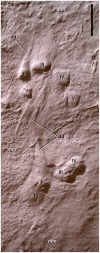

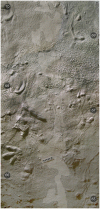
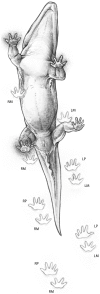

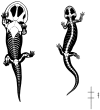
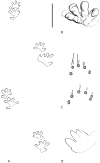
References
-
- Olsen PE, Galton PM (1984) A review of the reptile and amphibian assemblages from the Stormberg of southern Africa, with special emphasis on the footprints and the age of the Stormberg. Palaeontologia Africana 25: 87–110.
-
- Olsen PE, Sues H-D (1986) Correlations of the continental Late Triassic and Early Jurassic sediments, and patterns of the Triassic-Jurassic tetrapod transition. In: Padian K, editor. The Beginning of the Age of Dinosaurs. Cambridge: Cambridge University Press. pp. 321–351.
-
- Ellenberger P (1974) Contribution à la classification des pistes de vertèbres du Trias: les types du Stormberg d'Áfrique du Sud (II partie): le Stormberg Superieur-I. Le biome de la zone B/1 ou niveau de Moyeni: ses biocenoses). Palaeovertebrata Mémoire Extraordinaire: 1–202
-
- Smith RMH, Marsicano CA, Wilson JA (2009) Sedimentology and paleoecology of a diverse Early Jurassic tetrapod tracksite in Lesotho, southern Africa. Palaios 24: 672–684.
Publication types
MeSH terms
LinkOut - more resources
Full Text Sources
Other Literature Sources

